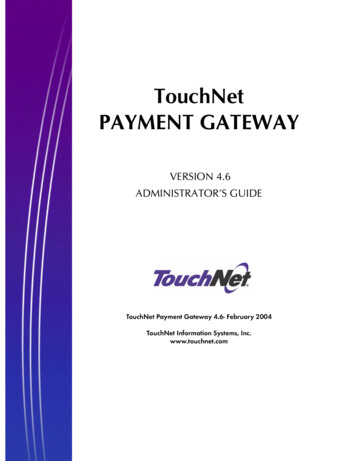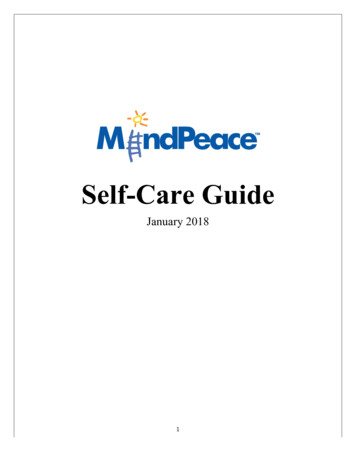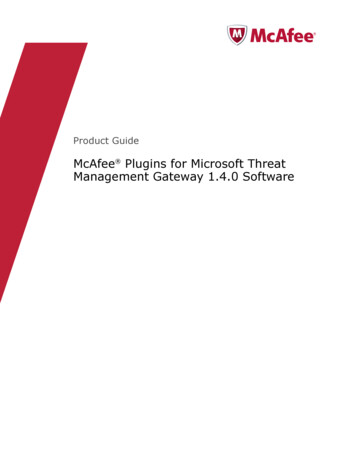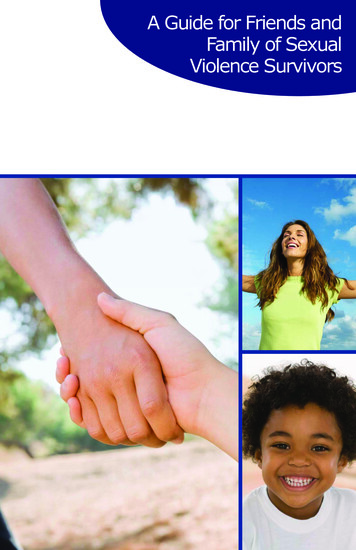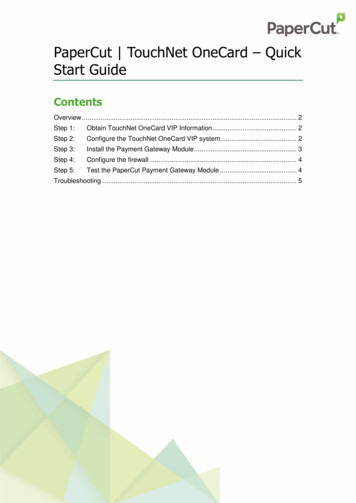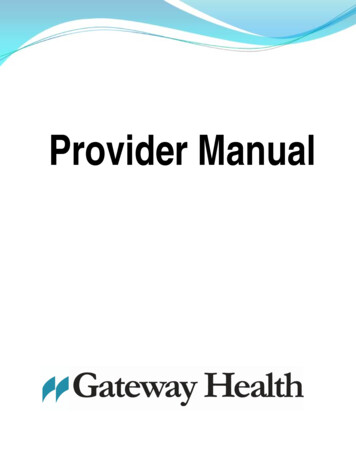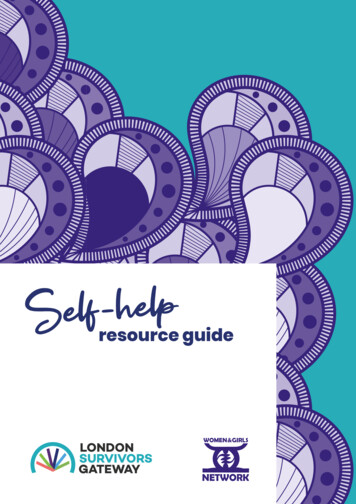
Transcription
plehfleSresource guideWOMEN & GIRLSNETWORK
WOMEN & GIRLSNETWORKWomen and Girls Network (WGN) wasestablished in 1987. Our overall aim is topromote, preserve and restore the mentalhealth and well-being of women and girls,to empower them to make a total andsustainable recovery from their experiencesof gendered violence.Women and Girls Network run the West London RapeCrisis Centre, which provides services include counselling,advocacy, body therapies, group work, a sexual violencehelpline and the London Survivors Gateway.Healing doesn't meanthe pain never existed. Itmeans the pain no longercontrols your life.2
Self-help resource guideLondon Survivors Gateway Women and Girls NetworkContentsUsing the guide5Section 1: Introduction6What is sexual violence?Resourcing yourself: emergencyself-care exercisesSection 2: Reactions to sexual violenceSection 3: Understanding howI react and how to copeAs each individual’s experience and reactionto sexual violence is unique, this guide offersan opportunity for you to explore what worksfor you at a pace that is right for you.8Self-care tip1017Keep a notebook, or use the spaces inthis guide, to write down what you arethinking and feeling. It can be a helpfulway to make sense of your thoughts.20What is the cause of my reactions?20Flashbacks and intrusive memories23My feelings24Memories and thoughts26My body28My behaviour30Self-harm32Eating distress34 Creating supportNightmares and sleep hygiene35 Gaining controlSection 4: Counselling36Section 5: How to supportsomeone you know38What is in this guideA) Understanding the link betweensexual violence and trauma Common reactions to sexual violence Identify ways to cope that work for youB) Exercises that might help Reducing feelings and responsesthat are painful to you Easing physical symptomsC) Self-reflection Space to reflect Becoming aware of your feelingsD) Self-care tools and tips Taking care of yourselfHOPE:Hold On Pain Ends4E) Affirmations and inspiration Find strength and hope from others Create your own affirmation5
Self-help resource guideLondon Survivors Gateway Women and Girls NetworkSECTION 1:IntroductionThe self-help guide is written to support those accessing the LondonSurvivors Gateway Service. The Gateway Service offers a specialist firstresponse to victims and survivors of rape and sexual abuse (age 13 orabove). A team of trained Navigators works with survivors over thephone to understand their support needs, explain the options availableand link the survivor with appropriate support services in London.As you come into contact with this servicethere may be many mixed feelings andquestions, not only about what help isavailable to you, but also in-terms ofunderstanding and making sense of yourresponse and reactions to the sexualviolence you have experienced.Each survivor who experiences sexualviolence will react in the aftermath in his orher own unique way. This guide offers someuseful information, tools and exercises tohelp you to support yourself, as you come tounderstand your feelings and responses. Theexercises and tools offered in this guide areones used successfully by survivors in theirrecovery from sexual violence. They drawfrom a body of resources used by survivorsand therapists within the Women and GirlsNetwork. You are invited to use those thatare helpful for you.6My mission in lifeis not merely tosurvive, but tothrive; and to do sowith some passion,some compassion,some humour, andsome style.Maya Angelou“Survivor” – In this guide, the term survivoris used to refer to an individual who hasexperienced and survived any form of sexualviolence and abuse. This includes rape,child sexual abuse, sexual assault, sexualharassment, stalking, forced marriage,female genital mutilation (FGM), ‘honourbased violence’, ‘ritual/faith based abuse’,child sexual exploitation, or other forms ofcommercial sexual exploitation (trafficking,pornography, prostitution).Sexual violence is a crime thatdisproportionately affects women andgirls. However, men, boys and all sectionsof society, including those who identify aslesbian, gay, bisexual, trans, queer or intersex(LGBTQI), able/disabled bodied, elders andthose from Black and minority ethnic (BME)and traveller communities, also experience it.In this guide we recognise that genderas well as the above identity characteristicscan affect the way in which an individualexperiences sexual violence and how theyare able to access support. We recognisethat for those who may identify with morethan one of these identities (e.g. a BlackLGBTQI disabled woman), the experience ofsexual violence can be even more challengingand complex in terms of the additionalbarriers and pressures that the individualneeds to navigate.In the guide, we are speaking to the commonexperience of sexual violence as a trauma andhow we can support the recovery from suchan experience. If you identify as BME, LGBTQI,Disabled and/or Traveller and you requiresome additional support for your specificneeds to compliment this guide, you canspeak with the Gateway on 0808 801 0860about what specialist services andresources are available. You may also wishto look at the service map on our websitewww.survivorsgateway.london7
London Survivors Gateway Women and Girls NetworkSelf-help resource guideWhat issexual violence?Sexual violence is a term used to describe any act of a sexualnature that a person did not consent to. This can include a rangeof experiences from unwanted touching or kissing to being forced toperform sexual acts. A lack of consent means that you did not wantor choose to take part in a sexual act or series of acts. It can alsomean that at the time it took place you did not have the freedomor capacity to make a proper choice.Things that might stop you from beingable to make a choice to consent are: Being drunk or under the influence of drugs Being unconscious or asleep Being under age - the legal age ofconsent is 16 Health or mental health problems ordisabilities that limited your choicesat the timeThings that can stop you from having thefreedom to make a choice include: Being threatened with violence againstyou or someone else Being forced, pestered or coerced Being blackmailed If there is a power imbalance betweenyou – for example they were a teacheror carerUnderstanding consentIt’s as Simple as Tea. You may find thisshort video helpful, which you can accessvia the link below:www.youtube.com/watch?v oQbei5JGiT8Sexual violence happens regardless ofage, race, religion, gender identity, class,sexuality, whether able bodied or disabled.If you are unsure about whether or notwhat you experienced was abusive, youmay find it useful to access confidentialand anonymous helplines to explore yourthoughts and feelings.You survived the abuse. You’regoing to survive the recovery.Remember: It was not your fault, the responsibilitylies with the attacker, not you. It is normal to feel angry, fearful, confused.Whatever your reactions are, they are normal. You are not alone, there is support available. Women and Girls Network’s sexualviolence helpline, for women and girls whohave experienced sexual violence at anypoint in their lifetime – 0808 801 0770 SurvivorsUK web chat, for male survivorswho want to explore their difficulties in aconfidential space The Rape Crisis National helpline,for women and girls who have experiencedsexual violence at any point in their lifetime– 0808 802 9999 Galop’s National LGBT domesticabuse helpline – 0800 999 542889
London Survivors Gateway Women and Girls NetworkflesruoygnicrResouBefore you startFacing the feelings and reactions to sexualviolence can be a challenge. To make thischallenge more manageable we can equipourselves with resources that empower usto feel able and ready to move ahead onthis courageous journey.Self-help resource guideEmergency self-careexercisesThese are quick exercises that you can learnand practice if you are feeling overwhelmed.These exercises are often called ‘GroundingTechniques’ as they can help with intensefeelings of anxiety or distress, maybe apainful memory or flashback. Groundingexercises can help to ground you back inthe present.Self-care tipChoose a couple of exercises that workfor you and practice, practice, practice it may take time.1011
Self-help resource guideLondon Survivors Gateway Women and Girls NetworkGrounding exercisesI am feeling overwhelmed, what can I do?1. Sensory grounding exercise 5,4,3,2,13. Use the breath Describe 5 things you can see in the room.Put a hand over your heart and a hand overyour belly and breathe deeply, followingthe breath into your belly, focusing on theconnections of your hands with your bodyand the gentle rise and fall of the movementas the breath comes in and out. Name 4 things you can feel (“my feeton the floor” or “the air in my nose”). Name 3 things you hear right now(“traffic outside”). Name 2 things you can smell rightnow (or 2 smells you like). Name 1 good thing about yourself.You should feel calmer and more at easeby the end of the exercise. Repeat the 5steps more than once if needed. Try outthe technique in different situations.2. Physical grounding technique Place both feet flat on the floor. Lean back into your chair, and make noteof the feeling of the chair under you andagainst your back. Cross your arms over your chest. Gently tap your shoulders, alternatingone side at a time.Alternatively, you can place your hands onyour thighs if you are in public, tapping oneleg at a time. Although not as effective asshoulder tapping, this technique can stillcalm you down.124. Walk, or stomp if it helps!If you can, go outside and walk barefoot,or with shoes on, taking in each step to feelyour feet make contact with the ground. Ifit is difficult to make connection, stomparound and really push your feet down.5: Use an objectTouch something that you enjoy the sensationof, a stone that is smooth, a crystal, a piece ofwood – anything that feels solid and that youcan use to remember where you are and thatyou are safe – you can carry this around withyou all day and every time you feel nervousjust throw your hands into your pocket toremember you are here and safe right now.6. WaterWash your hands or take a shower. Feelthe sensation of the water on your skin.Alternatively, drink some water or anotherbeverage. Slowly drink it, feeling the sensation ofthe water in your mouth, tongue and stomach.7. Make a listThink of a category and list all the thingsin this category; the dogs I like, musiciansbeginning with the name A or types ofvegetables. Concentrating on this list willmean that you are not able to think aboutall of the things that are making you feeloverwhelmed. Alternatively, count to tenor say the alphabet very slowly.8. Physical groundingAffirmationHave a list of self-soothing statementsthat you would say to someone whowas scared or afraid like “things arevery difficult for you right now and Iknow that, just hang in there, it does getbetter” or “you are a good person andsomething really bad has happened toyou, this is not your fault”.Stand against a wall. Physically push against it.Feel your feet rooting into the ground and yourhands against the wall. Then feel your muscles.What does it feel like when they tense, what isthe sensation of relaxing your muscles?Self-care tools and tips ind a smell that you love, such as anFaromatherapy essential oil, incense or ascented candle and diffuse the smell. Ifyou need to access this quickly you canput the essential oil on some cottonwool and gently breathe in.13
Self-help resource guideLondon Survivors Gateway Women and Girls NetworkCreating a comfort kitRelaxation TechniquesBelow are some things you may want to havein your comfort kit. It may be helpful to havean item for each of the five senses:Self-care tipBefore you startCreating a safe space in your mind Find a quiet place where you canpractice uninterrupted. An essential oil or smell that appeals toyou. This can be calming if you are feelinganxious. Spray the smell onto a cottonpad so you have it to hand.Create a comfort kit that reflects whoyou are. It can be playful, bold, brimmingwith things that are of significance toyou and above all, something you feelcomforted by. Get comfortable.(It may be helpful to voice record thisvisualisation and then play it back toyourself) Relaxation exercises can be doneat any time of the day. Sit or lie down in a comfortable, safe spacewhere you can completely relax. It might help to record lengthierexercises to play back and practice. If you want to, put on soft soothing musicThink of this as emotional first aid. This can be a small bag or box youcan fill with items that are soothing for you when you might be feelingsanxious or overwhelmed. A comforting or soft material, such as afeather for touch or even a stress ball. A way to feel grounded and soothed isthrough taste, including a sweet, fruit ormint teabag. Create a playlist or add in an item thatcreates a sound you find comforting. Keep a notebook or collection of picturesof family and friends, positive quotes andaffirmations for sight.Learning and practicing relaxation techniques can have a positiveeffect on enhancing a sense of well-being. Here are a few exercisesthat may help. Remember that trying something newcan take time, use the ones that workbest for you.Short exercises Focus on breathing from the abdomen.Breathe in fully, hold briefly and gentlyexhale. As you exhale, feel any tensionyou hold go with it. Try a deep sigh. Stretching and flexing muscles can help torelease tension. This can be a whole bodystretch or just the arms and hands. Now let yourself travel in your mind’s eyeto a favourite place, a healing place. Itcould be somewhere you have visited orwould like to visit. When you think of this place make sure youfeel peaceful, happy and safe. Now in yourmind’s eye, look around. What does thisplace look like? You can adjust this place to suit your needs.Are you alone? Are there other people? Arethere creatures, trees, plants or flowers?Maybe you are near water or high on a hillwith a beautiful view? Take it in. What isthe air temperature? Are you sitting,standing or lying down? Feel the safeground underneath you, supporting you. Choose your favourite weather. Listen for all sounds around you,just notice the sounds.Continued 1415
Self-help resource guideLondon Survivors Gateway Women and Girls NetworkSECTION 2:Reactionsto sexual violence Are there any smells you associate withyour safe place? The smell of the sea orcan you smell flowers?Self-care tip What are the sensations on your body inthe safe place? Are you relaxed in acomfortable chair or can you feel the sunwarm on your body?There are a number of apps thatare free to download that focuson relaxation techniques. And as you are there, drink in the safetyof this place, this place of your creation. Nobody can go there without yourpermission. There are no demands in this place,only nurturance and peace. Feel this safety deep within your being.Know that wherever you go in the outsideworld this peaceful place always lies withinyou and you can return again and again.Now when you are ready, gently allow yourconsciousness to return to this body, theexternal world, maybe wiggling fingers andtoes when you are ready. Good. Feel the effects in your body as youreturn from your safe place.Exercise adapted from the Trauma ToolkitI started off feelingconfused, anxious andblaming myself for theabuse that was inflictedonto me, but now I havecome to understand andaccept that it was notmy fault and I still have abright future that I havecontrol over and havethe right to feel happyand safe.Quote from a survivor1617
Self-help resource guideLondon Survivors Gateway Women and Girls NetworkSexual violence affects everyone differently; there is no right or wrongway to feel.Are there any other reactions you areexperiencing that are not listed? Writethem down.Try to think of yourself and seek the help and support you need. Below is a list of some of thecommon reactions that may be experienced because of sexual violence.You may find it useful to write all thesereactions down in your notebook. Building apicture of your response and reactions canshow you how you are being affected andwhat you can do to support yourself ineach area.Physical ve reactionsXIn my behaviourXIn my relationshipsXSweatingDepressionLoss ofconcentrationFeeling irritableDifficulties trustingother peopleHaving tensemusclesSadnessBlaming yourselfHaving disturbedsleepExpecting rejectionfrom other peopleHyperactivityHopelessnessLoss of memory/getting confusedabout thingsSelf-harming(page 32)Having difficultiesrelating to othersTired andexhaustedAngerMaking impulsivedecisionsRisky/hyper sexualbehaviourAvoiding emotionaland physicalintimacyMigraines orheadachesAggressionLoss iculties aroundpowerPhysical achesand painsGuilt and shameNightmaresBeing vigilant or onedgeBeing withdrawnand isolatingyourself fromothersBody dysmorphiaShock andnumbnessDissociation(page 21)Not wantingto go outHaving difficultiessetting healthyboundaries in nking/smokingPushing peopleaway who wouldlike to helpStruggling to find the words? You may wantto try these exercises:Dry mouthAnxietyFlashbacks(page 23)Eating more/less(page 34)Testing otherpeople’s loyaltiesIf my feelings were a colour it would be:Diarrhea/constipation/irritable bowels (IBS)Alienation/isolationLack of interest orenthusiasmGamblingSuicidal ideation(page 26)Problems withdecision-makingTaking prescriptiondrugsFeelings of griefand lossFeelings that are difficult for me:Self-reflection exerciseDifficult thoughts and feelings are anunderstandable response. Remember totake care of yourself during this time, useyour comfort kit or reach out for support,there are many organisations that can help.Use your notebook: Make a list of peopleor places that help and inspire you.AffirmationWrite your own power affirmation to counterany negative thoughts you are thinking.If my feelings had sound or music itwould be:Self-care tipBe compassionate towards yourself.1819
Self-help resource guideLondon Survivors Gateway Women and Girls NetworkSECTION 3:gnidnatsrednUhow I react and how to copeGetting over apainful experience ismuch like crossingmonkey bars. Youhave to let go atsome point in orderto move forward.What is the cause of myreactions?It can be useful to understand what happenswithin our brains and bodies at the time ofan assault to understand our responses.Our brain is a complex system that keeps ussafe in the face of danger. Once our personalsafety is threatened, it starts in motion asystem whereby our thinking part of the brainis pushed to one side, so that our instinctivepart, which can respond much faster, can bein control. This means that how we react inthe face of trauma and danger is often not inour conscious control and is managed by theinvoluntarily part of our brain developed toensure we survive any threat.There is a lot of social pressure on survivorsto have fought back, but this is the leastcommon response. Many survivors often livewith a great deal of guilt and regret that theydid not ‘run’ or ‘fight’ during the assault. Themost common response to sexual violenceis to freeze or flop, as often the first twodefences are not possible if the systemdetects that it could lead to more harm.So even though we think we know how wewould think and act in the face of danger(fight, scream, run), our logical mind is notin control but our responses are driven byinstinct alone and a priority is to keep safe.DissociationThe hormones that are released into ournervous system can, in situations like rapeand sexual abuse, keep our nervous systemstuck in high alert, ready to respond to adanger that may no longer be present. Thiscan mean that you are vigilant and sensitiveto responding to even the slightest triggeror memory of the event, as if it was takingplace again. These triggers may not evenbe conscious. Watching yourself in a situation as opposedto feeling a part of it.Dissociation can feel like you are Disconnected from your emotions and body. Floating and feeling ungrounded. Unable to tell where you end and otherpeople begin. Feeling as if the world around you isn’t real. Seeing objects change their shape, sizeand colour.The defensive survival reactions availableto humans are: Feeling like the world is lifeless orseeing it in a foggy way. Flight: when we are in danger, one responseis to try and escape by running away. Losing track of time and your surroundings. Unable to remember things; losingconcentration, missing appointments. Fight: trying to fight back can be aresponse to someone trying to hurt you. Freeze: here, the involuntary survivalpart of our brain takes over and freeze isa strategy to try and become invisibleand minimize the danger. Flop: when your body is trying to processso much information, a normal responsecan be to flop. This is because there are somany hormones running through your bodyin that moment that your body can becomeoverwhelmed by the traumatic event.20The freeze and flop defence is alsoclosely connected to what is described as‘dissociation’. Dissociation describes whathappens when the pain that is experienced,this can either be physical or emotional, is sooverwhelming that the only way to cope is todisconnect from the body in which the pain isfelt. If connection is lost with the body, it canbe difficult to stay present and grounded andthis is why grounding is necessary for healingfrom trauma. Friend: trying to engage and reason withthe attacker is another survival strategyintended to manage the risk and minimizethe damage from the attacker. Having confused memories or gaps. Appearing distant and disinterested.Things to remember Even though it might feel really scary and unnatural when this happens, it’s a totally normalresponse and is part of the brain’s way of responding to the impact of trauma. If you disassociated during the abuse, your brain has saved this as a good response totrauma. As a result, when you feel overwhelmed and stressed it will keep going back to thisinitial response that kept you safe. The brain is always growing and changing so the trick is to develop new skills and findother ways to make yourself feel safe when you experience a trigger.21
Self-help resource guideLondon Survivors Gateway Women and Girls NetworkFlashbacksand intrusive memoriesThese exercises can be helpful when you find yourself disassociating Keep your eyes open – it’s a simple onebut by keeping your eyes open you cankeep connected to what’s going on rightnow around you. Body scan – do this really slowly and tryand feel the tips of your toes, try to slowlymove them, see how the ground feelsunder your feet if you don’t have yourshoes on. If you do, then press your toes tothe tops of your shoes, then to the bottom.Try and think about how this feels trying toconnect with your foot. Move up and dothis slowly through your whole body. Say a statement – one that can help youto remember when and where you are e.g.“My name is . I am in my (room/workplace). I am safe. It is (the date).The colour of the walls is . etc.” Look at your hands - study how they look,think about how old your hands are (this isuseful if you are feeling younger than youactually are). Watch your fingers moving. Take several deep breaths - while you dothis imagine the breath moving throughyou, energising different parts of your body.Self-reflection exerciseIf possible, keep a journal when you arefeeling like you are disassociating. Writedown what you have been experiencingand describe it in detail. Talk about howdifferent parts of your body feel. You canthen use this as a guide to notice whenyou are about to disassociate and can usethe grounding exercises for support toremain present and in your body.Self-care tips Taking an Epsom salts, magnesiumflakes or essential oil bath can helpto relax you and release any buildupof tension in your muscles. If you are prone to losing track oftime, keep your screen clock visible.Wearing a watch is a practical solution,or setting small alarm remindersthroughout the day.Having flashbacks or dealing with intrusive memories can be acommon experience for survivors of sexual violence. It can feel asthough the event is happening all over again. These memories area way of the logical mind attempting to make sense of what hashappened and is a natural part of the healing process.Tips for dealing with a flashback Accept and reassure yourself that thisis a flashback. The abuse is over andyou survived. Use the grounding exercises andorienting exercise to the right, the 5,4,3,2,1exercise or connect with your comfort kitto help you come back to the present. Bring yourself back to the present bycomparing then and now. “Now I amhere in this room.” “Now I am wearing ”“The date and time is ”Exercise: Orientingand breathingTake a look around the room, move your headreally slowly from one side to the other andthen back again before coming back to thecentre. Doing this can help you to stimulatethe part of your nervous system which helpsyou to relax.Breathe Sit or stand comfortably with your backstraight. Put one hand on your chest andthe other on your stomach. Take a slow breath in through your nose,counting to four. The hand on your stomachshould rise. The hand on your chest shouldmove very little. Hold your breath for a count of seven. Exhale through your mouth to a count ofeight, pushing out as much air as you canwhile contracting your abdominal muscles.The hand on your stomach should move inas you exhale, but your other hand shouldmove very little. Inhale again, repeating the cycle until youfeel relaxed and centred.2223
Self-help resource guideLondon Survivors Gateway Women and Girls NetworkMy feelingsSelf-reflection exerciseIf it is safe for you, you might find it usefulto bring your memories out into the openby writing or drawing the sights, sounds,smells, emotions of the flashback. Onlydo this if it feels safe to do so and thatgetting it out of your mind could help you.Self-care tipGive yourself some time to recover, asflashbacks can be an intense experience.Be slow with yourself. This could meantaking a nap or having a bath, oilingand brushing your hair, giving yourself amanicure, pedicure or wrapping yourselfin a blanket and drinking a soothing herbaltea like chamomile.Affirmation“I am feeling because I am rememberingthe rape/sexual assault, but as I lookaround, I can see that the assault is nothappening right now and I am safe.”24Many survivors report beingoverwhelmed with the feelings thatthey have. It is useful tounderstand each feeling andexplore them to understand whythey are there.Anger – This is a normal reaction to what hashappened and is part of your recovery anda survival strategy. It’s part of our defenceresponse and tells us that a boundary hasbeen crossed. It’s OK to be angry and toexpress your anger in safe ways.Guilt and shame – These are what manysurvivors report after an assault and can bethe most destructive of feelings. Guilt is anaspect of trauma where the mind protectsyou by taking back control. You blameyourself through self-statements like, “Ishould have known better”, “I shouldn’t havegone out that night”, “It’s my fault becauseI’m gullible and too trusting”. Unfortunately,for survivors, blame is also a response tosocial conditioning and victim blaming in aworld that holds survivors responsible forsexual violence, citing what they have worn,not worn, drunk, etc. as reasons for thembeing blamed for the assault. These verysame conditions and myths create feelingsof shame that can stop survivors from talkingto someone or seeking support.Shock and numbness - Feeling shockedand numb is a very common responsesoon after a sexual assault. Reactionsto the emotional shock could be cryinguncontrollably, withdrawing or feelingnothing. Survivors can feel emotionallydetached, drained and disconnected fromwhat is happening around them.Anxious – Survivors can experience extremeanxiety as a result of the assault. This maybe experienced in physical symptoms suchas difficulties in breathing, muscle tension,nausea, stomach cramps or headaches.Alienation/isolation – A sense of differentnessand despair is often experienced if a survivoris unable to share their experiences withothers. The same feelings of guilt andsocietal attitudes towards blaming victimsprevent survivors from talking about theirexperiences. For individuals from theLGBTQI, BME and disabled communities,such feelings can be magnified.Exercise: Self-hug forcontaining big feelings(Peter Levine)Your thoughts and nervousness can becomeoverwhelming, out of control, or scattered. Itcan become difficult to feel your edge. Thegoal of this exercise is to feel and developyour body as a container to nurture and helpself soothe yourself.Instructions: Place your right hand under your left armpit, next to your heart. Then place the other hand over the upperpart of the other arm; you are givingyourself a hug. Pay attention to your body. Let yourself settle into the position. Allow yourself to feel supported by it.Allow yourself to feel contained. Watch and see if anything shifts with yourbreathing, bodily sensations, and how youfeel in space. See if you can sit with it a while and let itshift your perceptions of yourself and theworld somewhat before coming out of it.Self-reflection exerciseWrite or draw to express your feelings.You could use colours to represent eachfeeling. Identify and name each one ofyour feelings as a way of letting yourfeelings out into the open.25 pa
The self-help guide is written to support those accessing the London Survivors Gateway Service. The Gateway Service offers a specialist first response to victims and survivors of rape and sexual abuse (age 13 or above). A
